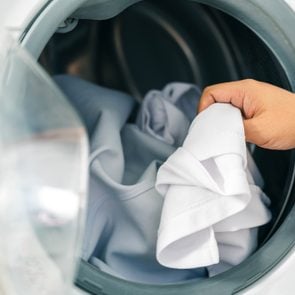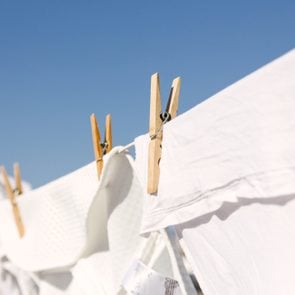How to Select the Best Dryer Settings for Your Clothes
Updated: Mar. 20, 2024
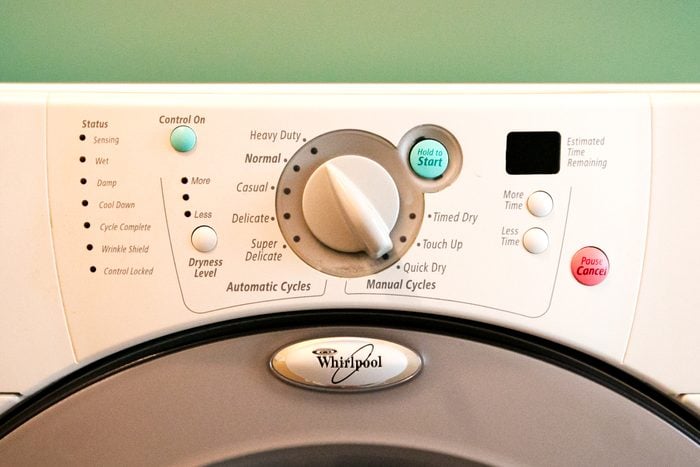
Protect your clothes and save energy (and money!) by choosing the right dryer settings for your laundry needs.
Old-school clothes dryers were relatively basic, offering very few dryer settings. In fact, most people simply used the same setting for all their clothes, regardless of fabric. Things sure have changed. The top-selling clothes dryers of 2021 offer a wide range of features and options for taking your clothing from damp to dry. These days, doing your laundry is not only easier but also involves less risk of damaging your clothes—especially if you’re reviewing the laundry symbols on a garment before laundering.
There are two main factors that go into dryer settings, according to Bounce senior scientist Sammy Wang: temperature and time. “In the past, these settings could be controlled by the consumer—for example, high, medium, or low temperature for X minutes,” she says. “However, today, many appliance manufacturers create dryer settings with the temperature and time factors preset and name them based on the type of load being dried, including permanent press and delicate.”
While dryer settings are intended to help simplify how you do laundry, they can sometimes create confusion, “especially if you are drying a mixed load of laundry or aren’t familiar with the setting names and what type of clothes they refer to,” she points out. Still wondering if heat will shrink your favorite sweater or whether you should use dryer sheets or dryer balls? You’re in luck. We got the lowdown from laundry experts on how to select the best dryer setting for every type of clothing.
Check laundry symbols to determine dryer settings
First and foremost, always look at the laundry symbols on individual clothing item labels before you toss a garment in the dryer (or washer, for that matter). “They will tell you how best to dry,” says Shawn Ashby, Whirlpool laundry brand manager.
While you’ll notice a bunch of different symbols on the tag, you’ll want to pay close attention to the square when it comes time to dry. That’s the symbol for drying, and the various elements—circle, dots, lines, or an X—indicate whether and how to dry your clothing item.
If a clothing item can be tumble-dried, the symbol will tell you how. “Just like with wash symbols, underscored lines indicate cycle, and black dots represent temperature,” Ashby says.
Some items should never end up in the dryer. If that’s the case, the square on the clothing label will have a circle inside it and an X through it. If there’s no circle, you’ll be air-drying the item. “Surprisingly, there’s more than one way to do it,” Ashby notes.
What does tumble dry mean?
When it comes to drying your clothing, you have two options: air-dry or tumble-dry. If you see the words “tumble dry” on your clothing label, or notice the tumble dry laundry symbol, you can dry the garment in your dryer. If your clothing items don’t clearly specify that they require delicate or air-dry methods, the Whirlpool brand recommends the tumble dry setting.
“The tumble dry symbol is a square with a large circle inscribed in it,” says Ashby. “Some garments may require a certain heat setting depending on how many small black dots are inside the circle.” The more dots, the higher the heat.
How hot does a dryer get?
The maximum heat of a dryer is dependent on the model. “On average, the temperature is between roughly 120 to 155 degrees Fahrenheit, with around 160-degree peak temperatures possible,” notes Ashby. Of course, if your dryer is not drying, temps might not reach that high. That’s when it’s time to take steps to fix the issue or call in the pros.
Air-dry setting
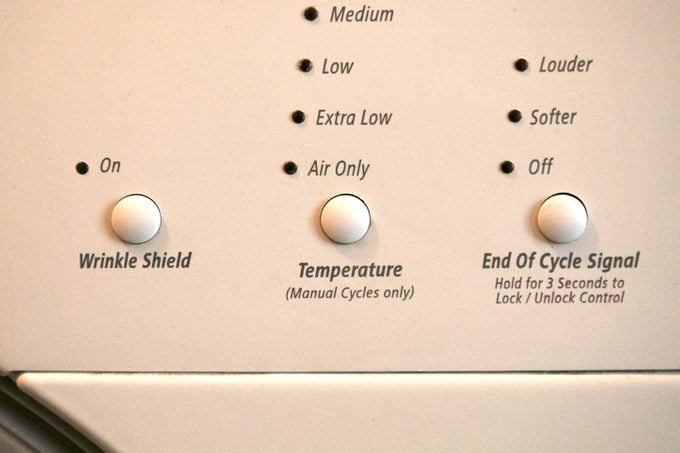
Best for:
- Items that need fluffing
- Pillows
- Comforters
You can have the best washer and dryer, but that won’t matter if your garment will get damaged in the process. That’s where air-drying comes in. There are two main methods of air-drying. The first—and the one that probably pops into your head when you hear the term “air-dry”—dries clothes without a dryer. The other involves a clothes dryer.
“For air-drying, there are four different ways to go about this, including drip-dry, dry in the shade, hang dry, and dry flat. The item’s label will indicate the drying symbol, and the lines inside the square will tell you how the item should be air-dried,” says Ashby.
We know what you’re thinking: If my clothing label says to air-dry and I shove it in the machine, won’t it shrink or end up otherwise damaged? Not if you use the right dryer setting. According to Wang, the air-dry setting on the machine does not add any heat to the dryer. “Instead, it circulates room-temperature air into the dryer and tumbles clothes to help circulate air and fluff clothes,” she explains.
This setting is best for fluffing things like pillows or comforters. While the biggest pro to using your machine’s air-dry setting is that there is little risk of fabric becoming damaged, the major con is that because this cycle only circulates room-temperature air, “it does not dry wet items efficiently,” Wang points out.
Delicate vs. gentle
Best for:
- Rayon
- Chiffon
- Embroidered items
- Items with embellishments like beads
- Workout wear
- Sweaters
- Anything wool
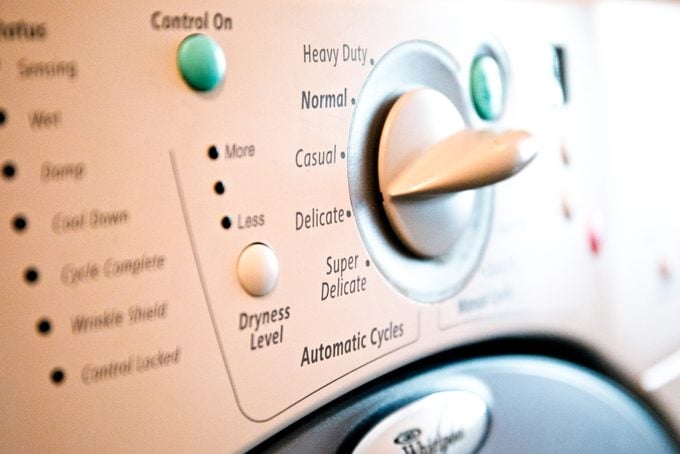
As you might’ve guessed, the delicate (or gentle) cycle is for your most delicate items. This dryer setting uses the lowest heat and a longer time to dry items. “The lower heat is good for more delicate fabrics, like rayon and chiffon, or items with embellishments or embroidery,” says Wang.
Ashby adds that the delicate setting is also great for workout gear. “It is important to dry spandex/exercise clothing on low heat because it prevents the fabric from fraying, fading, and stretching,” he says.
While the name suggests you could use the delicate cycle on items like lingerie, bras, or sweaters, Wang maintains it is best to air-dry these items by hanging them or laying them flat to dry. “The heat tumbling can negatively impact the shape and fit or cause snags on other garments in the dryer,” she says. Similarly, before you wash your delicates, make sure you know how to wash silk and how to hand-wash clothes.
Permanent press
Best for:
- Synthetic fabrics
- Wrinkle-resistant clothing
- Workout wear
The permanent-press cycle uses medium heat and often includes a cool-down period to help you get wrinkles out of clothes, explains Wang. “This cycle is good for most common garments, like shirts and pants, as well as clothes made from synthetic fibers like polyester [such as athletic wear] because they dry quicker than natural fibers like cotton,” she says.
Because synthetic fibers are more prone to building static, she recommends adding a dryer sheet. What do dryer sheets do? A sheet added to a load of laundry will help prevent static and wrinkles. Alternatively, you can use dryer balls. They’re an eco-friendly alternative to dryer sheets and accomplish the same static- and wrinkle-banishing.
What does “permanent press” mean?
You know that the permanent press setting can reduce wrinkles and may help you avoid steaming or ironing your clothing. But what exactly does “permanent press” mean? The term refers to the treatment that manufacturers add to garments like button-down shirts and slacks. (You know, the stuff you used to wear to your office job before working from home made you re-evaluate your comfort.) According to Wang, the treatment helps fabric resist wrinkles and maintain creases.
“Permanent press refers to clothes that can remain minimally wrinkled if you wash and dry them properly,” adds Ashby. The permanent press dryer settings help you do just that.
Steam cycle
Best for:
- Wrinkled clothing
- Items that could use refreshing, like those that smell musty after being in storage
You can invest in one of the best steam irons to rid your clothing of wrinkles, but if you’re looking for a quick fix, there’s an easy trick: Adjust your dryer settings. Some machines now have a steam cycle, during which steam is created or pumped into the dryer drum to help remove wrinkles. “The steam cycle uses water and heat to refresh fabrics without rewashing,” explains Ashby. “It gently releases wrinkles, removes odors, and is ready in minutes.”
But, Wang clarifies, this cycle will not dry clothes. Still, if you inevitably forgot to take a load of laundry out of the dryer (no shame—we’ve all been there), you can run the steam cycle to ditch the wrinkles before putting clothes away.
Automatic vs. timed dry
Automatic is best for:
- Fabric care
- Energy savings
- Athletic wear
- Baby clothes
- Towels
- Bedsheets and comforters
- Cotton and linen clothes
- Jeans
Timed dry is best for:
- Damp loads that need a little more drying time
“Automatic dry” cycles use a moisture sensor in the dryer to detect when clothes are dry, states Wang. It helps you avoid puzzling out exactly how long a load of laundry should take.
“During the automatic drying cycle, the dryer senses the air temperature and moisture level needed for the load throughout the drying cycle. The dryer will shut off once the load reaches the selected dryness,” explains Ashby.
Because the automatic dry setting only uses as much heat as needed, it is a great way to save money and energy, Ashby says. It can also help prevent damage to any clothes, as it won’t dry clothes any longer than needed.
“Timed dry,” on the other hand, dries clothes for a set period of time, determined by the user. “Beware, this sometimes results in shrinkage, wrinkling, or static due to over-drying,” warns Ashby. “Timed dry is best for the occasional damp load that needs a little more drying time, such as jeans.”
So, what type of heat do automatic and timed dry use? “Depending on the model, the heat setting would stay the same for both automatic and timed drying. The difference with timed drying is that it runs on the amount of time set,” Ashby says.
Sources:
- Sammy Wang, Bounce senior scientist
- Shawn Ashby, Whirlpool laundry brand manager


